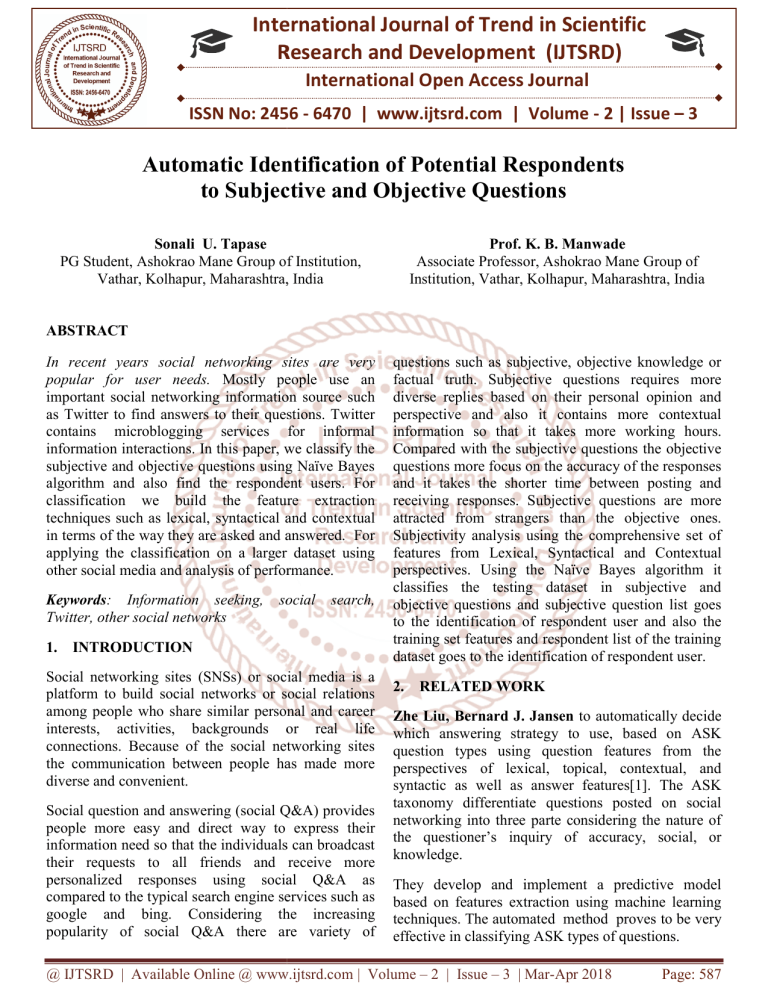
International Journal of Trend in Scientific
Research and Development (IJTSRD)
International Open Access Journal
ISSN No: 2456 - 6470 | www.ijtsrd.com | Volume - 2 | Issue – 3
Automatic Identification of Potential Respondents
to Subjective and Objective Questions
Sonali U. Tapase
PG Student, Ashokrao Mane Group
roup of Institution,
Vathar, Kolhapur, Maharashtra, India
Prof. K. B. Manwade
Associate Professor, Ashokrao Mane Group of
Institution,
nstitution, Vathar, Kolhapur, Maharashtra, India
ABSTRACT
In recent years social networking sites are ver
very
popular for user needs. Mostly people use an
important social networking information
ormation source such
as Twitter to find answers to their questions. Twitter
contains microblogging services for informal
information interactions. In this paper, we classify the
subjective and objective questions using Naïve Bayes
algorithm and also find the respondent users. For
classification
fication we build the feature extraction
techniques such as lexical, syntactical and contextual
in terms of the way they are asked and answered. For
applying the classification on a larger dataset using
other social media and analysis of performance.
Keywords:: Information seeking,
Twitter, other social networks
1.
social
search,
INTRODUCTION
Social networking sites (SNSs) or social media is a
platform to build social networks or social relations
among people who share similar personal and career
interests, activities,
tivities, backgrounds or real life
connections. Because of the social networking sites
the communication between people has made more
diverse and convenient.
Social question and answering (social Q&A) provides
people more easy and direct way to express their
information need so that the individuals can broadcast
their requests to all friends and receive more
personalized responses using social Q&A as
compared to the typical search engine services such as
google and bing. Considering the increasing
popularity of social Q&A there are
re variety of
questions such as subjective, objective knowledge or
factual truth. Subjective questions requires more
diverse replies based on their personal opinion and
perspective and also it contains more contextual
information so that it takes more working hours.
Compared with the subjective questions the objective
questions more focus on the accuracy of the responses
and it takes the shorter time between posting and
receiving responses. Subjective questions are more
attracted from
rom strangers than the objective ones.
Subjectivity analysis using the comprehensive set of
features from Lexical, Syntactical and Contextual
perspectives. Using the Naïve Bayes algorithm it
classifies the testing dataset in subjective and
objective questions
ons and subjective question list goes
to the identification of respondent user and also the
training set features and respondent list of the training
dataset goes to the identification of respondent user.
2.
RELATED WORK
Zhe Liu, Bernard J. Jansen to automatically decide
which answering strategy to use, based on ASK
question types using question features from the
perspectives of lexical, topical, contextual, and
syntactic as well as answer features[1]. The ASK
taxonomy differentiate questions posted on social
networking into three parte considering the nature of
the questioner’s inquiry of accuracy, social, or
knowledge.
They develop and implement a predictive model
based on features extraction using machine learning
techniques. The automated method proves to be very
effective in classifying ASK types of questions.
@ IJTSRD | Available Online @ www.ijtsrd.com | Volume – 2 | Issue – 3 | Mar-Apr
Apr 2018
Page: 587
International Journal of Trend in Scientific Research and Development (IJTSRD) ISSN: 2456-6470
Bernard J. Jansen and Mimi Zhang, Kate Sobel,
Abdur Chowdury. Uses [2] the Word of mouth
(WOM) process of conveying information from
person to person and plays a major role in customer
buying decisions. The relationship between company
and customers are affected from the effects of services
in the commercial sectors.
Dejin Zhao, Mary Beth Rosson provide a new
communication channel for people to broadcast
information that they likely would not share otherwise
using existing channels (e.g., email, phone, IM, or
weblogs) and also provide a variety of impacts on
collaborative work (e.g., enhancing information
sharing, building common ground, and sustaining a
feeling of connectedness among colleagues)[3].
tweet, whether or not there is a question mark in the
middle of tweet and also consecutive capital letters.
The contextual features used to find the presence of
hashtags, emoticons and mentions in the tweet. For
the classification of testing dataset it uses Naïve
Bayes algorithm. It is used for text retrieval and text
categorization. The proposed system identifies the
respondent users of subjective question list, training
set features and the respondent user list of training set
features.
A. System Architecture
F. Maxwell Harper, Daniel Moy, Joseph A.
Konstan using [4] machine learning techniques to
automatically classification questions in informational
or conversational, learning in the process about
categorical, linguistic, and social differences between
different question types. To distinguishing
Informational and Conversational Questions in Social
Q&A Sites.
Baoli Li, Yandong Liu, Ashwin Ram, Ernest V.
Garcia, Eugene Agichtein. Using [5] caseinsensitive features and n-gram techniques to remove
spelling errors and poor formatting, and POS features
to attempt to capture simple grammatical patterns. To
automatically identifying subjectivity orientation of
questions in QA communities, and explore a
supervised machine learning solution with different
features.
3.
PROPOSED WORK
In proposed system, the different Social Networking
Sites (SNS) are used for the collection of different
questions. Using the percentage ratio the questions are
classified in training dataset and testing dataset. It
uses the Lexical, Syntactical and contextual features
for the extraction of data. In Lexical feature N-gram is
used to count the frequencies of all unigram, bigram
and trigram tokens that appeared in training data. POS
(Part Of Speech) tagging used to distinguish the two
types of questions, as it can add more context to the
words used in the interrogative tweets. The MPQA
subjectivity lexicon used to count the number of
subjective clues in each question. The Syntactic
features describe the format of subjective or objective
information-seeking tweet. It also includes the length
of the tweet, number of clauses or sentences in the
Figure 1: Architecture of Automatically Identify
Potential Respondents to Subjective and
Objective Question
The proposed system provides following modules:
Data Collection:
In this module, the proposed system refers different
Social Networking Sites (SNS) for the collection of
data. That data is divided in Training and Testing data
for the processing.
@ IJTSRD | Available Online @ www.ijtsrd.com | Volume – 2 | Issue – 3 | Mar-Apr 2018
Page: 588
International Journal of Trend in Scientific Research and Development (IJTSRD) ISSN: 2456-6470
Pre-processing:
In this module includes the cleaning, transformation,
feature extraction and selection of data which is
collected from the different Social Networking Sites
(SNS).
Feature Extraction: It contains main three features
are as follows:
1. Lexical:
The lexical features are N-gram, POS tagging and
MPQA subjectivity lexicon. The N-gram feature is
used to count the frequencies of all unigram, bigram
and trigram tokens. Part Of Speech (POS) tagging
used to distinguish the two types of questions as it can
add more context to the words used in the
interrogative tweets. The MPQA subjectivity lexicon
is used to count the number of subjective clues in each
question.
2. Syntactical:
It describes the format of subjective or objective
information seeking tweet. It also includes the length
of the tweet, number of sentences/clauses in the tweet,
whether or not there is a question mark in the middle
of the tweet and also consecutive capital letters in the
tweet.
3. Contextual:
It includes the presence of hash tags, emoticons and
mentions in the tweet.
Classification of Testing dataset using Naive
Bayes: The Naive Bayes is supervised learning
algorithm which is used to classify the data. It is used
for text retrieval and text categorization. It only
requires a small amount of training data to estimate
the parameters necessary for classification. It is a
model which is easy to build and particularly useful
for very large data sets.
Identification of Respondent User: The subjective
question list of training and testing dataset is
automatically handover to the respondent user.
4.
SCOPE OF THE WORK
Social Networking Sites (SNS) provide people to easy
and convenient way for the communication and their
individual needs. It automatically identifies the
potential respondents for subjective and objective
questions using different Social Networking Sites.
The Pre-processing is used to remove the rare words,
lowercase letters and stemming of data in the tweet.
The features are extracted from the Lexical,
Syntactical and Contextual features in tweet. In
proposed system the Naïve Bayes supervised learning
algorithm is used to classify the testing dataset.
The purpose of identifying potential respondent users
for removing the confusion between subjective and
objective questions and also to give the appropriate
answer to the user.
5.
CONCLUSION
In this paper, different features of extraction
techniques were studied and a new system is
proposed, that finds potential respondents to
subjective and objective questions. The features are
extracted from the Lexical, Syntactical and
Contextual features in tweet and also remove the rare
words, lowercase letters and stemming of data in the
tweet. Naïve Bayes supervised learning algorithm is
used to classify the testing dataset. The new proposed
system will automatically finds the potential
respondents for removing the confusion between
subjective and objective questions and also gives the
appropriate answer to the user.
REFERENCES
1. Zhe Liu, Bernard J. Jansen, “ASK: A Taxonomy
of Accuracy, Social, and Knowledge Information
Seeking Posts in Social Question and
Answering”,march 2016.
2. B. J. Jansen, M. Zhang, K. Sobe, and A.
Chowdury, “Twitter power: Tweets as electronic
word of mouth,” J. Amer. Soc. Inf. Sci. Technol.,
vol. 60, no. 11, pp. 2169–2188, Nov. 2009.
3. D. Zhao and M. B. Rosson, “How and why people
Twitter: The role that micro-blogging plays in
informal communication at work,” in Proc. ACM
Int. Conf. Supporting Group Work, 2009, pp.
243–252.
4. F. M. Harper, D. Moy, and J. A. Konstan, “Facts
or friends?: Distinguishing informational and
conversational questions in social Q&A sites,” in
Proc. SIGCHI Conf. Human Factors Comput.
Syst., 2009, pp. 759–768.
@ IJTSRD | Available Online @ www.ijtsrd.com | Volume – 2 | Issue – 3 | Mar-Apr 2018
Page: 589
International Journal of Trend in Scientific Research and Development (IJTSRD) ISSN: 2456-6470
5. B. Li, Y. Liu, A. Ram, E. V. Garcia, and E.
Agichtein, “Exploring question subjectivity
prediction in community QA,” in Proc. 31st Annu.
Int. ACM SIGIR Conf. Res. Develop. Inf. Retr.,
2008, pp. 735–736.
6. P. Biyani, S. Bhatia, C. Caragea, and P. Mitra,
“Using non-lexical features for identifying factual
and opinionative threads in online forums,”
Knowl.-Based Syst., vol. 69, pp. 170–178, Oct.
2014.
7. Z. Liu and B. J. Jansen, “Almighty Twitter, what
are people asking for?” Proc. Amer. Soc. Inf. Sci.
Technol., vol. 49, no. 1, pp. 1–10, 2012.
8. N. Aikawa, T. Sakai, and H. Yamana,
“Community QA question classification: Is the
asker looking for subjective answers or not?” IPSJ
Online Trans., vol. 4, pp. 160–168, Jul. 2011.
@ IJTSRD | Available Online @ www.ijtsrd.com | Volume – 2 | Issue – 3 | Mar-Apr 2018
Page: 590

